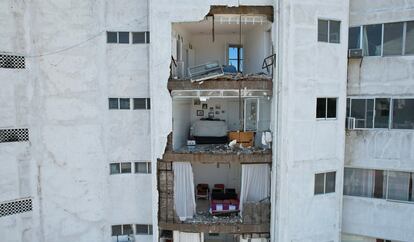Mexican earthquake’s proximity to Guerrero seismic gap causes alarm
The 7.1 magnitude quake that shook central Mexico on September 7 is close to a 110-km long strip of land that has not registered major seismic activity in a century. Could that soon change?

The large earthquake that shook central Mexico on September 7 has left the country’s seismologists on alert due to the epicenter’s proximity to the Guerrero seismic gap, a tectonic belt that has not recorded a major earthquake for more than a century. More violent earthquakes have occurred in the area of the Mexican state of Guerrero, but Tuesday’s quake began at a point on the coast closest to Mexico City, which is why it was felt so strongly in the capital. In addition, the earthquake began in an area of the country where a magnitude 8+ earthquake has been expected for over 100 years, explained Víctor Manuel Cruz-Atienza, a researcher at the Geophysics Institute of the National Autonomous University of Mexico (UNAM).
Every year, Mexico records an average of about 30,000 earthquakes, and Guerrero state is hit by about 25% of all national seismic activity. For this reason, the Guerrero seismic gap is something of an anomaly in not experiencing a 7+ magnitude earthquake for more than 110 years. Cruz-Atienza explained that if the seismic gap were to rupture, it would cause a major earthquake, potentially stronger than 8.2 in magnitude. Tuesday’s earthquake could have repercussions on Guerrero’s seismic gap, he added, which continues to accumulate unreleased energy. “It was a small earthquake of low to moderate magnitude, which tells us there are certain portions of the gap that are ready to break, but these are insufficient to trigger a larger earthquake yet,” Cruz-Atienza said.
Intensity
I
II
III
IV
V
VI
VII
VIII
IX
Tuesday’s earthquake occurred at 8.47pm local time, 11 kilometers southeast of Acapulco, and at a depth of 10 kilometers, according to information from Mexico’s National Seismological Service. “This is an inverse type fault. This type of fault is characteristic of convergence zones between tectonic plates, as occurs during contact between the Cocos and North American plates,” the technical report from the service stated. So far, more than 200 aftershocks have been registered from the September 7 earthquake, the highest with a magnitude of 5.2.
For the last five years, Cruz-Atienza and a group of UNAM and University of Kyoto researchers have monitored the waters of the Mexican Pacific for any indication of movement in the Guerrero seismic gap. This November the research team will retrieve data from the ocean floor to see how the Earth’s crust was deformed prior to Tuesday, and hope to gain insights into the post-seismic deformation caused by this latest earthquake.
When will the Guerrero seismic gap break? This is the question that all the specialists are asking, said Carlos Valdés González, another researcher at the Institute of Geophysics of UNAM, and additionally at the Center for Mexican Studies at the University in Costa Rica. “We are doing a number of analyses to try to determine the impact that this earthquake and its aftershocks have had in transferring or allowing seismic energy to be released in the Guerrero gap,” he said. “It is a very important thing that we don’t know and we will have to make a series of evaluations, but we know that an earthquake is pending in the Guerrero seismic gap. We cannot stop an earthquake from happening, but we can mitigate its effects if we act carefully,” he added.
Although Valdés González acknowledges that it is very likely the recent earthquake will trigger more seismic activity in Mexico, as happened in 2017, it is not possible to foresee how much more. He pointed out that despite a coincidence of dates with earthquakes in September 2017, it would not be possible to draw out a conclusion for future movements in the area. Unlike four years ago, the population had more time to prepare after receiving an earlier alert signal.While specialists agree that it is still not possible to predict an earthquake or avoid the danger they pose, with sufficient technical information available it will be possible to mitigate the risk associated with a future earthquake with its epicenter in the Guerrero seismic gap.
Tu suscripción se está usando en otro dispositivo
¿Quieres añadir otro usuario a tu suscripción?
Si continúas leyendo en este dispositivo, no se podrá leer en el otro.
FlechaTu suscripción se está usando en otro dispositivo y solo puedes acceder a EL PAÍS desde un dispositivo a la vez.
Si quieres compartir tu cuenta, cambia tu suscripción a la modalidad Premium, así podrás añadir otro usuario. Cada uno accederá con su propia cuenta de email, lo que os permitirá personalizar vuestra experiencia en EL PAÍS.
¿Tienes una suscripción de empresa? Accede aquí para contratar más cuentas.
En el caso de no saber quién está usando tu cuenta, te recomendamos cambiar tu contraseña aquí.
Si decides continuar compartiendo tu cuenta, este mensaje se mostrará en tu dispositivo y en el de la otra persona que está usando tu cuenta de forma indefinida, afectando a tu experiencia de lectura. Puedes consultar aquí los términos y condiciones de la suscripción digital.
More information
Archived In
Últimas noticias
Most viewed
- Reinhard Genzel, Nobel laureate in physics: ‘One-minute videos will never give you the truth’
- Oona Chaplin: ‘I told James Cameron that I was living in a treehouse and starting a permaculture project with a friend’
- Pablo Escobar’s hippos: A serious environmental problem, 40 years on
- Why we lost the habit of sleeping in two segments and how that changed our sense of time
- Chevy Chase, the beloved comedian who was a monster off camera: ‘Not everyone hated him, just the people who’ve worked with him’










































